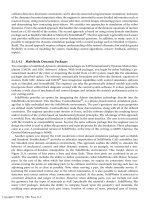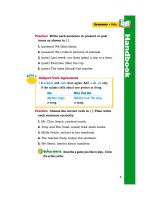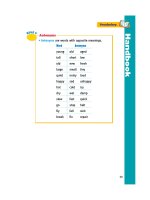treasures grammar and writing handbook grade 2 phần 5 ppt
Bạn đang xem bản rút gọn của tài liệu. Xem và tải ngay bản đầy đủ của tài liệu tại đây (235.95 KB, 10 trang )
Antonyms
• Antonyms are words with opposite meanings.
Word Antonyms
young old aged
tall short low
old new fresh
large small tiny
quiet noisy loud
happy sad unhappy
hot cold icy
dry wet damp
slow fast quick
go stop halt
fly fall sink
break fix repair
Vocabulary
39
Vocabulary
Words Correct Usage Correct Usage
Lie means “to rest
on something”
I like to lie on my
bed and read a book.
Lay means “to put
something down.”
I will lay my coat
on the chair.
lay/lie
It’s is a contraction.
It is the shortened
form of “it is.”
It’s hot outside!
Its is a possessive
pronoun. Its has
no apostrophe.
The cat likes its
new toy.
its/it’s
Into means “move
to the inside of.”
I stepped into the car.
In means
“inside of.”
The bird is in
the cage.
in/into
Well is often an adverb.
Well describes a verb
by telling “how.”
Rena did very well
on the math test.
Good is an
adjective that
describes a noun.
I am having a
good day.
good/well
May means “to be
allowed.”
May we go to the
movies this afternoon?
Can means “to be
able to.”
My dog can run
very fast.
can/may
40
Problem Words
Some words in the English language are confusing.
Sometimes these words are not used correctly. The
following charts will help you see how to use these
words in the correct way.
Vocabulary
Words Correct Usage Correct Usage
You’re is a
contraction. It is
the shortened
form of “you are.”
I think you’re a
great friend.
Your is a possessive
pronoun. It means
“belonging to you.”
Is that your
backpack?
your/you’re
Too is an adverb.
It means “also.”
I want a pizza, too.
To means “in the
direction of.”
She walked to the
door and opened it.
to/too
Than means “to
compare something.”
Your dog is bigger
than my dog.
Then means “next.”
I walked home from
school and then I
ate a snack.
then/than
They’re is a
contraction. It is
the shortened form
of “they are.”
They’re going on a
field trip tomorrow.
Their is a possessive
pronoun. It means
“belonging to them.”
That is their house.
their/they’re
Set means to
“put something in
a certain place.”
I set the cup on
the saucer.
Sit means “to be
seated.” The
teacher asked us
to sit in a circle.
sit/set
41
Create your own chart of problem words.
Include words from this chart or other words you
sometimes get confused. Write sentences to help you
remember how to use the words correctly.
Q
U CK
WRITE
Spelling
Difficult Words to Spell
For many writers, some words are difficult to spell.
You can use this list to check your spelling. You can
also practice spelling these words correctly.
Homophones
Homophones are words that sound the same. But
they are spelled differently, and they have different
meanings. See and sea are examples of homophones.
again
along
also
always
another
any
anything
around
balloon
because
been
before
buy
charge
clothes
color
could
dear
decide
does
early
family
finally
first
friend
heard
hurt
know
little
might
money
myself
o’clock
off
once
our
please
pretty
really
right
said
school
soon
started
sure
than
their
they
third
through
tired
together
until
upon
were
when
which
while
would
write
ant
aunt
bare
bear
be
bee
blew
blue
buy
by
dear
deer
eye
I
flour
flower
hear
here
hour
our
knew
new
knot
not
know
no
meat
meet
one
won
road
rode
sea
see
some
sum
their
there
threw
through
whole
hole
wood
would
to
too
two
42
Spelling
Words You Often Use
Here is a list of words that writers often use in
their writing. Test yourself and see how many of
these words you can spell correctly.
a
about
after
all
am
an
and
are
around
as
at
away
back
ball
be
because
big
black
book
box
bring
but
by
came
can
color
could
day
did
didn’t
do
don’t
down
eat
find
first
for
found
four
friend
from
get
girl
go
got
had
have
he
her
him
his
home
house
I
if
in
into
is
it
just
know
last
left
like
little
live
look
made
man
me
men
morning
mother
my
night
no
not
now
of
on
one
or
our
out
over
people
play
pretty
put
red
run
said
saw
say
school
see
she
so
some
soon
stand
that
the
them
then
there
they
things
think
this
time
to
too
two
up
upon
us
very
want
was
we
well
went
were
what
when
where
white
who
will
wish
with
woman
women
would
year
you
your
43
Spelling
Spelling Rules and Strategies
Learning these spelling rules can help you spell
many words.
1. When words end in silent e, drop the e when
adding an ending that begins with a vowel.
(save + ed = saved)
2. When a base word ends with a consonant
followed by y, change the y to i when adding the
ending. (story + es = stories)
3. When a base word ends with a vowel followed by
y, do not change the ending when adding suffixes
or endings. (day = days)
4. When a one-syllable word ends in one vowel
followed by one consonant, double the consonant
before adding an ending that begins with a vowel.
(run + ing = running; drop + ed = dropped)
5. The letter q is always followed by u. (quick)
6. No English words end in j, q, or v.
7. Add -s to most words to form plurals or to change
the tense of verbs. Add -es to words ending in x,
z, s, sh, or ch. (map = maps; bus = buses; wish =
wishes; fox = foxes)
44
Spelling
Use these tips to help you become a better speller.
1. Learn about sound-alike words such as hear and
here. Be sure you use the right one.
2. Use spell-check on a computer. Spell-checkers are
not perfect! If you write a word that sounds like
the word you need, spell-check will not catch the
mistake.
3. Think of a word that rhymes with the new word.
Rhyming words often have the same spelling
pattern. (b + and = band; h + and = hand)
4. Use words you know how to spell to help spell
new words. Word beginnings and endings can
help. (st
ar + bone = stone)
5. Make up clues to help you remember the spelling.
(“What you k
now is OK.” K begins know.)
6. Break the word into word parts or syllables.
(be cause)
7. Look for a smaller word in a new word to help you
write the new word. (hear
d has hear in it)
8. Word families have words with the same endings.
Use word families to help you spell new words.
(pen, ten)
9. Use the dictionary to look up spellings of words.
10. Study each letter in words that do not match
spelling patterns or rules. Say and write the words
carefully.
11. Think of when you have seen the word before.
Think of how it looked. Write the word in different
ways to see which one looks correct. (fal
, faul, fall)
12. Keep a Personal Word List in your Spelling
Journal. Write words you have trouble spelling.
45
46
Play
A play is a story that is written to be acted out.
Characters use actions and words, called dialogue,
to tell the story.
Jack and the Beanstalk
Characters: JACK
MOTHER
TESSY THE COW
OLD MAN
GIANT
Setting: Long ago in a small village
Act I
Scene I: The play begins in Jack’s house. Jack
and his mother are sitting near an empty fireplace.
Tessy is chewing Mother’s straw hat.
MOTHER (grabbing her hat away from Tessy)
You must sell the cow, Jack, so we can buy
something to eat.
JACK No, Mother, Tessy is the only friend I have.
TESSY (nodding her head) Moo.
JACK But, Mother…
MOTHER Don’t you “but, Mother” me. The cow goes
or I go.
TESSY (pushing Mother out of the door) Moooo!
MOTHER Get this cow away from me!
A play has
a title
A play has a
cast of
characters
An act is one
part of a play
The setting
tells where and
when the play
takes place.
Stage
directions in ( )
tell how the
characters
move and act.
A character’s
words are
written after
his or her
name.
Writing Forms
Practice Think of characters from a story you
like. Think about what they do and say. Then
write the beginning of the story as a play.
In a poem, words are used in special ways to help
you imagine an idea or a subject. A poem is different
from other writing. It has a special sound and form.
47
Writing Forms
Poem
August Heat
In August, when the days are hot,
I like to find a shady spot,
And hardly move a single bit —
And sit —
And sit —
And sit —
And sit!
Some poems
have more
than one part,
or stanza.
This poem has
one stanza.
Some poems
rhyme. The
words hot and
spot, bit and
sit rhyme in
this poem.
The way that
lines of this
poem are
written helps
show that an
action takes
place over a
period of time.
Repeated
words help
stress an
important idea
in this poem.
Practice Look around your classroom or outside.
Choose an object or an idea to write a poem
about. Then write the poem and draw a picture
to go with it.
• Choose a fun or interesting object or idea.
• Write words that make a picture of the object or idea.
• Do you want your poem to rhyme? Do you want an
idea to repeat? Use rhyming words or repeated words
in your poem.
• How many stanzas will your poem have? Write
as many stanzas and lines as you want.
• Give your poem a title.
GUIDELINES FOR WRITING A POEM
48
Business Letter
A business letter is a special kind of letter. It is
more formal than a friendly letter. You can write a
business letter to a company or to a person.
140 Allen Street
Dallas, Texas 75200
March 4, 20__
Mrs. Rita Montez, President
Montez Pet Food
600 Park Lane
Dallas, Texas 75230
Dear Mrs. Montez:
I would like to enter my cat in your “Perfect Cat
Contest.” His name is Tiger. He loves your food. I think my
cat’s friendly face should be on boxes and cans of your cat
food.
I am sending you a picture of Tiger. If you like him,
you can write to me. You can also call me at 555-4495.
Thank you.
Yours truly,
Alexis Wilson
Alexis Wilson
Writing Forms
The heading
gives the
writer’s
address and
the date.
The inside
address gives
the name and
address of
the person
to whom you
are writing.
The greeting
includes Dear
and the name
of the person.
Use a colon
after the name.
In the closing, use a
capital letter for the first
word only. Use a comma
after the closing.
Practice Think of something you like about your
school. Write a business letter to your principal.
The body of
the letter tells
what you want
to say.
The signature is the signed
name of the writer. Print or
type the name underneath
the signature.









